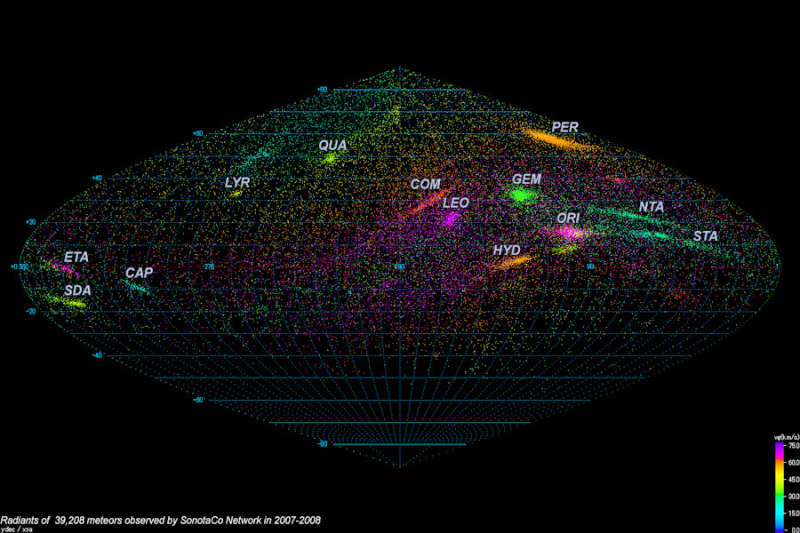
|
Credit & Copyright: SonotaCo Network, Japan
Explanation:
Where do meteors come from?
Visible meteors are typically sand-sized
grains of ice and rock that once fragmented from comets.
Many a meteor shower has been associated with a
known comet, although some
intriguing
orphan showers do remain.
Recently, a group of
meteor enthusiasts created a network
of over 100 video cameras placed at 25 well-separated locations across
Japan.
This unprecedented network recorded not only 240,000 optically
bright meteors over two years,
but almost 40,000 meteors seen by more than one station.
These multiple-station events were particularly interesting because they enabled
the observers to extrapolate meteor trajectories back into the
Solar System.
The resulting radiant map is shown above, with many
well known meteor showers labelled by the first three letters of the
home constellation.
Besides known meteor showers,
eleven new showers were identified
by new radiants on the sky from which
meteors appear to flow.
The meteor sky is ever changing, and it may be possible
that new shower radiants will appear in the future.
Research like this could also potentially identify previously unknown comets or asteroids
that might one day pass close
to the Earth.
|
January February March April May June July August September October November December |
| ||||||||||||||||||||||||||||||||||||||||||||||||
NASA Web Site Statements, Warnings, and Disclaimers
NASA Official: Jay Norris. Specific rights apply.
A service of: LHEA at NASA / GSFC
& Michigan Tech. U.
Based on Astronomy Picture
Of the Day
Publications with keywords: meteor - meteor shower
Publications with words: meteor - meteor shower
See also:
- APOD: 2025 December 15 Á Gemini Meteors over Snow Capped Mountains
- APOD: 2025 August 25 Á The Meteor and the Star Cluster
- APOD: 2025 August 6 Á Meteor before Galaxy
- APOD: 2024 December 10 Á The Great Meteor Storm of 1833
- APOD: 2024 November 27 Á The Meteor and the Comet
- Meteor over the Bay of Naples
- Quadrantids of the North
